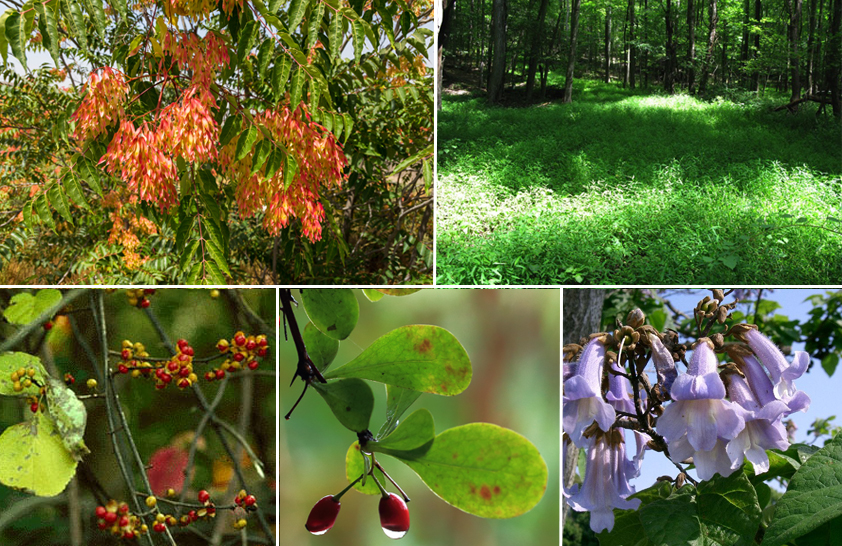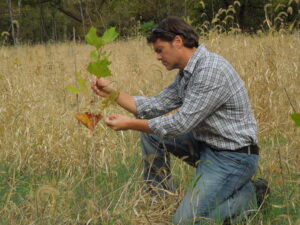by Aliya Uteuova

A white-tailed deer browses for food in the forests of the Smithsonian Environmental Research Center. (Credit: John Parker/SERC)
For years, scientists have attempted to unravel why some invasive plants escape the grazing of hungry herbivores.
It turns out, the chemical makeup of some invasive plants protects them from being eaten. In a new paper, scientists have taken a closer look at invasive plant species in forests of the Smithsonian Environmental Research Center (SERC) in Maryland. In the new study, published in the August issue of Ecology and Evolution, they found that five common plant invaders have a chemistry just quirky enough to make animals like deer and insects avoid them. The results suggest that their strange chemistry has helped fuel some successful invasions into SERC’s Maryland forests.
The movement of plants and animals to different regions, both deliberate and accidental, dates back to the 1400s.

Brian Sedio led a new discovery revealing that some invasive plants succeed because they’re less tasty to plant-eating animals. (Photo courtesy of Brian Sedio)
“Human activity has dramatically reshaped the planet,” said Brian Sedio, the lead author of the paper and an assistant professor at the University of Texas at Austin. Redistributing invasive species means that we often have the same rats, same pests, same weeds around the world, which comes with a huge economic impact.
The research site in Maryland contains relatively young forests, with trees 75 to 120 years old, and species typical of those in the mid-Atlantic United States. Native species include American beech, oak, tulip poplar, sweetgum and green ash. The introduced invasives include vines, woody shrubs, wineberries, Japanese honeysuckle and grasses like Japanese barberry and Japanese stiltgrass.
The researchers compared 15 invasive plant species to the 46 native species that grow in SERC forests. The invasive species they studied represent 90% of all invasive plant species in SERC forests, while the natives represent nearly 71% of all native plant species there. Overall, the invasive plants were chemically different from the natives. But five invaders particularly stood out. The tree of heaven (Ailanthus altissima), the princess tree (Paulownia tomentosa), Japanese barberry (Berberis thunbergii) and Japanese stiltgrass (Microstegium vimineum) largely escaped deer and insects alike. The fifth, an invasive vine called Asian bittersweet (Celastrus orbiculatus), didn’t deter hungry deer but did turn off insects.

These five invasive plants have a chemistry that makes them less tasty to herbivores in the eastern U.S. Clockwise from top left: Tree of heaven, Japanese stiltgrass, princess tree, Japanese barberry and Asian bittersweet.
For the hungry animals in the study, the scientists focused on the diets of Japanese beetles, woolly bear caterpillar, and white-tailed deer, the predominant large herbivore in the region. These animals stayed clear of the invasive species that had the most exotic chemistry. Strangely, many invasive plants had soft leaves, which normally would make them more desirable. But they grow slowly and can’t afford to lose energy. Therefore they invest a lot in defense mechanisms which might deter the herbivores.
“Think of people who refuse to eat spicy or exotic food,” said John Parker, one of the co-authors of the paper and principal investigator of SERC’s Terrestrial Ecology Lab. “Native herbivores might not eat invasive plants because they have chemistry that they’re not used to eating.”

John Parker examines a tree sapling in a forest restoration experiment at the Smithsonian Environmental Research Center. (Credit: Kristen Minogue/SERC)
In a single field season from April to August, Parker collected 231 leaf samples at the 2,650-acre SERC campus, comprised of rolling hills covered in forests and farmland. The scientists analyzed each sample individually using ultra-high-performance liquid chromatography and mass spectrometry that separated, identified, and quantified the molecules of each leaf. Using a technique called “tandem mass spectrometry,” the scientists were able to identify the compounds in the leaves by blasting them into pieces, matching them against a library of known compounds and comparing fragmentation patterns.
“I’ve been working on these species for almost two decades and thinking about it for a long time,” Parker said. “Before this new technology, we didn’t have the chemical know-how to isolate and identify so many chemicals in so many species all at once. That’s the real progress of this paper.”
The fact that some invasive plants are less tasty to herbivores is contributing to their successful, widespread invasion in Maryland forests. But chemistry may not tell the whole story. It’s also possible that these introduced invasive species might be more tasty to herbivores in their native ranges. Their chemical distinctiveness here in Maryland might result in a lack of enemies that keep them in check.
For Sedio, figuring out the white-tailed deer’s response is the next step to understanding why herbivores generally don’t prefer invasive species.
“Understanding mechanisms behind biological invasions can help us prevent them in the future, and address the problem of invasive species,” Sedio said.
A copy of the study, “Chemical novelty facilitates herbivore resistance and biological invasions in some introduced plant species” is available at https://onlinelibrary.wiley.com/doi/full/10.1002/ece3.6575.
Photo attributions:
Tree of Heaven: Jebulon, public domain
Japanese stiltgrass: John Parker/SERC
Princess tree: KENPEI, licensed under Creative Commons License Attribution-Share Alike 3.0 Unported.
Japanese barberry: Dominicus Johannes Bergsma, licensed under the Creative Commons License Attribution-Share Alike 3.0 Unported Asian bittersweet: National Park Service

